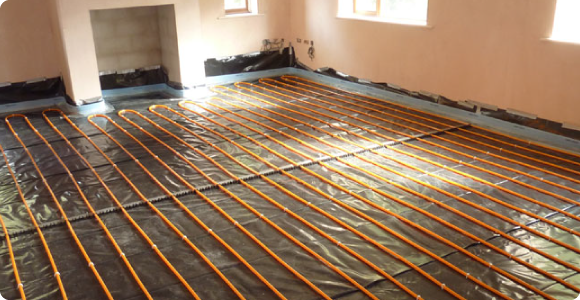Trying to figure out which underfloor heating system to choose is never straight forward. The best choice will depend on your personal project, as well as which type of heat source you’ll be using to power the underfloor heating. Here are your options:
Water-based Underfloor Heating
Water underfloor heating systems are usually best suited to new build or partial renovations, like a new extension or a new floor slab. The reason behind this is because water systems need a large amount of depth; a normal floor build up will needs 100mm insulation, 16mm heating pipes and 50mm screed or 65-70mm sand and cement screed. This becomes tricky when building this into an existing build.
As well as this there are more subtle water systems that requires less depth. These are known as ‘overlay’ panels with a 10mm or 16mm pipe installed into the panel. Despite these systems offering a perceived advantage over the 16mm pipe systems, we believe it’s hard to install and give a long lasting result.
Water systems also benefit from the large number of renewable heat sources to warm the water, like Air Source Heat Pumps, Ground Source Heat Pumps, Biomass or Thermal-dynamic panels. Wet underfloor heating bring the most out of these products because of the low water temperature that’s flowing around the heating pipe.
For instance, radiators need 6-80d flow temperature, compared with underfloor heating that can be as low as 35-40d, which can be just off a heat pump.
Electric underfloor Heating Systems
Electric underfloor heating systems aren’t hyped all that much, due to the lack of experience of Underfloor Heating Installers when discussing these systems.
The great thing about this system is the low profile build up, which means when you remodel a room you can have the benefits of underfloor heating without the annoyance and expense of digging deep into the floor to home large heating pipes.
A common thing most customers will say is the benefit of not compromising the existing heating system and that it’s a separate entity. This means it can be used to complement central heating or by itself as a primary heat source.
The perception is that electric UFH costs an arm and a leg to run, which isn’t really true. There have been bad experiences everywhere, but we believe from overall feedback that a properly designed and built system is a cheap option than oil heating, electric storage heaters and LPG.
Electric underfloor heating systems are perfect for existing floors, upper floors and those who want to reap the benefits of underfloor heating but don’t have a chance to install a wet system.












